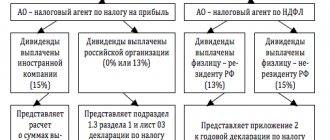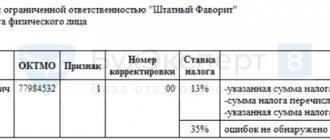Home — Documents
- Losses
- Provision for doubtful debts
- Expenses for transport, food and housing of employees
- Control ratios
Check your income tax return before filing it. Since 2017, a new procedure has been in force for expenses, losses and reserves. See examples of how to reflect these changes in the declaration. At the end of the article there is a table that will help you check the report.
Losses
In the 2021 declaration, take into account losses from previous years in a new way. They can be written off within 50 percent of the tax base (Article 283 of the Tax Code).
Note. Report using the old form. They will not have time to approve the new declaration by the deadline.
Another change: starting from 2021, it was allowed to carry forward losses without a limitation in the number of years (clause 2 of Article 283 of the Tax Code). Previously, it was possible to take into account past losses only for ten years. But there is another condition - you can transfer losses that occurred no earlier than 2007, in the order in which the company incurred them (clause 3 of Article 283 of the Tax Code, clause 16 of Article 13 of the Federal Law of November 30, 2016 No. 401-FZ ).
Keep primary documents that confirm the amount of losses. Otherwise, the tax authorities will not recognize them, they will charge additional income tax and fine them.
Let's look at an example of how to reflect the transfer of losses in the income tax return (letter of the Federal Tax Service dated January 9, 2017 No. SD-4-3/61).
Example 1. How to reflect losses from previous years
The company made a loss in 2021 and made a profit in 2021 (table below).
| Loss for 2021, rub. | Profit for 2021, rub. | Amount of loss that can be taken into account in 2021, rub. | Remaining loss at the beginning of 2021, rub. |
| 1 400 000 | 1 200 000 | 600 000 (1 200 000 × 50%) | 800 000 (1 400 000 – 600 000) |
Let's enter the data into the income tax return for 2021. Information on losses for previous periods is included in Appendix No. 4 to sheet 02. Appendix No. 4 is filled out in the declaration for the first quarter and for the year. In the declaration for the first quarter, the accountant indicated uncarried losses at the beginning of the year. And in the annual declaration he reflected the balances both at the beginning and at the end of the year. Sample below.
Preliminary assessment of the tax base
Based on an analysis of the income and expense parts of the income tax return, the inspector compares the tax bases for various taxes. For example, if the declaration declares a significant share of labor costs, then the amounts of UST accruals should also be significant.
If a company has declared significant amounts of VAT to be reimbursed through the supply of products for export, the inspector can “estimate” the income of this company based on the level of world prices for exported goods.
In addition, the inspectors will be interested in the significant difference in the indicators of your organization’s declaration compared to the indicators of companies conducting similar activities. They are compared both according to the inspectorate’s internal data and based on requests from other tax inspectorates for information.
And if a company, operating in a highly profitable area, is unprofitable or low-profit, the likelihood of an on-site inspection increases. Therefore, if this difference in indicators can be explained by any objective reasons, then reflect your arguments in the explanatory note to the annual reports.
Provision for doubtful debts
Reflect in the declaration the expenses for the reserve for doubtful debts, taking into account the changes that apply from 2021.
Include in the reserve only the difference between receivables and payables if your company has counter-obligations to the debtor (clause 1 of Article 266 of the Tax Code). For example, a counterparty owes you 300,000 rubles, and you owe him 100,000 rubles. To calculate the reserve, take the amount of debt in the amount of 200,000 rubles.
Attention! Compare the reserve for the year with the limit - 10 percent of this year's revenue. Otherwise, inflate the costs of the reserve.
Reduce by counter creditor, first of all, those receivables that arose earlier. These amendments to the Tax Code have been in effect since January 1, 2021, but the Ministry of Finance had previously recommended that the reserve be considered this way (letter dated June 20, 2017 No. 03-03-RZ/38289).
The reserve in tax accounting is calculated on the last day of each reporting and tax period. Therefore, determine the amount of the reserve as of December 31, 2021. The reserve includes doubtful debts in the amount of 100 percent if the delay is more than 90 days, and 50 percent if the delay is from 45 to 90 days inclusive (clause 4 of Article 266 of the Tax Code).
Don’t get confused: starting from 2021, the limit for the reserve for the first quarter, half a year, nine months is determined by one rule, and for the year - by another. For the reporting period, you took as a limit 10 percent of revenue for that period or for 2021, whichever is greater. When calculating the reserve at the end of the year, consider the limit from revenue for 2021. Revenue for the previous year cannot be taken into account.
Compare the reserve with the balance as of September 30. If the new amount is greater, include the difference in expenses, if less - in income (clause 5 of Article 266 of the Tax Code).
If you do not create a reserve in 2021, transfer the entire balance as of December 31 to income.
Example 2. How to reflect the provision for doubtful debts
As of December 31, 2021, the accountant identified a doubtful receivable and calculated a reserve for it - 320,000 rubles. There are no bad debts that can be written off using the reserve. Revenue for 2021 amounted to 5 million rubles. The remaining indicators for calculating the reserve are in the table.
| Balance of reserve as of September 30, 2017, rub. | Expenses on the reserve, which the company took into account in the declaration for nine months, rub. | Calculated reserve as of December 31, 2017, rub. |
| 200 000 | 200 000 | 320 000 |
The calculated reserve must be compared with the limit - 10 percent of this year’s revenue:
5 000 000 ₽ × 10% = 500 000 ₽.
The reserve as of December 31 does not exceed the limit: RUB 320,000. < 500,000 rub.
Since the reserve as of December 31 is greater than the balance at the end of the last quarter, the accountant attributed the difference to non-operating expenses:
320 000 – 200 000 = 120 000 ₽.
For simplicity, let’s assume that the company has no other non-operating expenses. In the annual declaration, the accountant reflected the expenses for the reserve on an accrual basis: 320,000 rubles. (200,000 + 120,000), as in sample 2.
Example of income tax reconciliation.
ABC Company is a manufacturing entity that is making a tax reconciliation for the year ended December 31, 20×8. You have the following information:
- 1. Depreciation charges for the year 20×8, allowed in accordance with tax legislation, amount to CU 103,000. Accounting depreciation included in operating expenses is CU85,000. The carrying amount of property, plant and equipment is CU800,000. The tax depreciation previously deducted is CU208,000, based on tax returns up to year 20×8.
- 2. In 20×8, the company increased its product warranty obligations by CU2,500. Warranty costs are not taxable until the company pays the claim. Warranty claims paid in 20×8 amounted to CU3,100.
- 3. Advertising expenses included in operating expenses are CU900. These expenses are not deductible for tax purposes.
- 4. The tax rate for 20×8 is 30% (28% in 20×7).
- 5. Statement of financial position (before tax) and income statement are given below:
| Statement of financial position as at 31 December 20×8 | |||
| Assets | Sum | Capital and liabilities | Sum |
| Capital | |||
| Fixed assets | Authorized capital | 500 000 | |
| Fixed assets | 550 000 | retained earnings | 412 368 |
| long term duties | |||
| Current assets | Warranty | 8 000 | |
| Accounts receivable | 350 000 | Deferred tax liabilities (from 20×7 years) | 9 632 |
| Reserves | 130 000 | ||
| Cash and cash equivalents | 95 000 | Short-term liabilities | |
| Accounts payable | 195 000 | ||
| Total assets | 1 125 000 | Total capital and liabilities | 1 125 000 |
| Income Statement for the year ended 31 December 20×8 | |
| Revenue | 2 402 000 |
| Cost of sales | -1 910 000 |
| Gross profit | 492 000 |
| Operating expenses | -400 000 |
| Operating profit | 92 000 |
| Financial expenses | -12 000 |
| Profit before tax | 80 000 |
Task:
Calculate current income tax expense, deferred tax expense and prepare tax reconciliation.
Solution:
The challenge with this example is that you need to understand tax reconciliation in the context of financial statements, tax returns, and other information.
It would be unwise to show an example of a tax reconciliation without revealing the full picture.
Before attempting any tax reconciliation work, please ensure you have the following information:
- Statement of Financial Position;
- Statement of profit or loss and other comprehensive income;
- Tax return (or detailed income tax calculation);
- A detailed calculation of deferred tax assets or liabilities at the end of the previous reporting period.
- A detailed calculation of deferred tax assets or liabilities at the end of the current reporting period.
Without these 5 important documents in hand, you should not waste your time and start working on a tax reconciliation.
Step 1. Prepare all necessary documents and calculations.
In our example, we have items 1 and 2, but we do not have tax returns and deferred tax calculations.
First, let's prepare a tax return.
1. Calculation of current income tax. We will start with the accounting profit and then make any necessary adjustments.
Current income tax = (80,000 + 88,400 - 106,000) * 30% = CU18,690
| Description | Sum |
| Accounting profit (A) | 80 000 |
| Add: | |
| Depreciation | 85 000 |
| Warranty expenses reserve (20×8) | 2 500 |
| Advertising expenses | 900 |
| Add total (B) | 88 400 |
| Subtract: | |
| Tax depreciation | -103 000 |
| Paid warranty obligations | -3 100 |
Note. You can see that instead of subtracting the positive difference between tax depreciation and accounting depreciation, we divided this adjustment by 2 numbers. This is much better for understanding how temporary differences are taken into account in the calculation.
2. Calculation of deferred tax for the current year. The best way is to put all the assets, liabilities and other items (such as tax losses) into a table and calculate the temporary differences and deferred taxes.
| Article | Book value (A) | Tax base (B) | Time difference (C=AB) | Deferred tax (-30%*C) |
| Fixed assets | 550 000 | 489 000 | 61 000 | -18 300 |
| Accounts receivable | 350 000 | 350 000 | 0 | 0 |
| Reserves | 130 000 | 130 000 | 0 | 0 |
| Cash and cash equivalents | 90 000 | 90 000 | 0 | 0 |
| Warranty | -8 000 | 0 | -8 000 | 2 400 |
| Accounts payable | -195 000 | -195 000 | 0 | 0 |
| Total | -15 900 |
Notes:
- Assets - with a '+' sign and liabilities - with a '-' sign
- The tax base of fixed assets is their book value in the amount of CU800,000. less tax depreciation made up to 20×8 in the amount of CU 208,000. and tax depreciation for 20×8 in the amount of CU 103,000.
- A tax rate of 30% applies (20×8 year rate).
3. Calculation of deferred tax for the previous year. This is also very important because you need to reconcile how the temporary differences were carried forward.
Here the method is the same as before, only the amounts and rate of the previous year are used.
In this example, we do not have financial statements for the previous year, so we will focus only on two temporary differences:
| Article | Book value (A) | Tax base (B) | Time difference (C=AB) | Deferred tax (-28%*C) |
| Fixed assets | 635 000 | 592 000 | 43 000 | -12 400 |
| Warranty | -8 600 | 0 | -8 600 | 2 408 |
| Total | -9 632 |
Notes:
- The deferred tax figure should appear on the balance sheet in the same amount (9,632).
- The carrying amount of property, plant and equipment is the carrying amount at 31 December 20×8 of CU550,000. plus depreciation charges in 20×8 in the amount of CU85,000. = CU 635,000
- The tax base of fixed assets is their cost in the amount of CU 800,000. less tax depreciation up to 20×8 in the amount of CU 208,000.
- The carrying amount of the guarantee liabilities is their carrying amount at 31 December 20×8 in the amount of CU8,000. plus paid warranty obligations for CU 3,100. minus the amount of newly formed liabilities in the amount of CU 2,500.
- A tax rate of 28% applies (for 20×7).
Step 2. Calculation of total income tax expenses.
Total tax expenses consist of:
- Current income tax expenses: CU 1,890 (based on 1 above);
- Deferred income tax expense: CU 6,266 (see below).
Total income tax expense at 20×8 = CU18,690 + CU 6,268 = CU 24,958
Deferred income tax expense is calculated as the difference between:
- Deferred tax liability as at 31 December 20×8: CU15,900 (calculation 2 above) and
- Deferred tax liability as at 31 December 20×7: CU9,632 (calculation 3 above).
If anything, this is very important to understand how the deferred tax expense arose in case your tax reconciliation doesn't add up.
| Article | Sum |
| Deferred tax expense related to fixed assets | 5 400 |
| Deferred tax expense related to warranty liabilities | 180 |
| Increase in deferred tax liabilities as a result of an increase in the tax rate | 688 |
| Total deferred tax expense | 6 268 |
How these numbers were obtained:
1. Deferred tax expenses related to fixed assets are calculated based on the actual current income tax:
- Accounting depreciation for CU85,000;
- Minus tax depreciation by CU 103,000;
- Multiply by 30%.
2. Deferred tax expenses related to the warranty obligation are calculated based on the actual current income tax:
- New provision for 20×8 of CU 2,500;
- Less claims paid at 20×8 for CU 3,100;
- Multiply by 30%.
3. The increase in deferred tax liabilities as a result of an increase in the tax rate is calculated as:
- Opening balance of deferred tax liability at CU9,632.
- Adjust to take into account the change in rate from 28% to 30%: 9,632/28*2 = 688 cu.
Expenses for transport, food and housing of employees
You can include expenses for food, transportation and housing for employees in your declaration. Officials now allow such costs to be taken into account, but on the condition that the company reflects them as labor costs (Article 255 of the Tax Code).
The Ministry of Finance considers such expenses to be wages in kind (letter dated September 14, 2016 No. 03-04-06/53726). Payments in kind should not exceed 20 percent of salary. It is safer to comply with this limit (Article 131 of the Labor Code).
The company has the right to take into account food costs if they are provided for in the employment or collective agreement. Another condition for writing off these costs is that the company must determine the amount of food for each employee. If this amount cannot be established, and only the total amount of food expenses is known, it will not be possible to take them into account when calculating income tax (letters from the Ministry of Finance dated January 9, 2017 No. 03-03-06 /1/80065, dated October 23, 2017 No. 03- 15-06/69405).
The company can take into account compensation for the costs of renting housing for non-resident employees if this is part of the remuneration provided for in the employment contract (letter of the Federal Tax Service dated October 17, 2017 No. GD-4-11/20938).
If employees cannot get to and from work by public transport, companies enter into an agreement with a transport organization. State in the employment contract that you provide workers with transportation. Then you can take these expenses into account when calculating income tax (letter of the Ministry of Finance dated January 10, 2017 No. 03-03-06/1/80079).
Example 3. How to include food expenses in your declaration
The production company pays for meals for employees based on an employment contract. The cost of food for production workers and contributions accrued on these amounts is included in direct costs, and for administration - in indirect costs. The remaining expenses for 2021 are in the table below. The accountant reflected these indicators in Appendix No. 2 to sheet 02 of the declaration, as in sample 3.
| Cost of food for production employees and contributions from these expenses, rub. | Other direct expenses, rub. | Cost of administration meals and contributions from these expenses, rub. | Other indirect costs, rub. |
| 800 000 | 10 000 000 | 100 000 | 3 000 000 |






